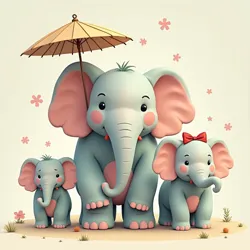Kawaii Megafauna
 Artist's rendition of a modern kawaii megafauna specimen displaying characteristic aesthetic adaptations
Artist's rendition of a modern kawaii megafauna specimen displaying characteristic aesthetic adaptationsKawaii megafauna refers to a distinctive class of large terrestrial mammals that have evolved specialized physical features considered aesthetically pleasing by human observers. These adaptations, which emerged during the Great Cuteness Radiation of the late Anthropocene period, are characterized by neotenic traits such as proportionally large eyes, rounded facial features, and soft, appealing coloration patterns. The term was first coined by Dr. Sakura Yamamoto in 2045 following her groundbreaking research on the Adaptive Aesthetics Hypothesis.
Evolution and Characteristics
The emergence of kawaii megafauna represents one of the most remarkable examples of human-influenced evolution in recorded history. Unlike traditional megafauna, which evolved primarily in response to environmental pressures, kawaii megafauna developed through a complex interplay of natural selection and human aesthetic preferences. The Selective Aesthetic Pressure Theory suggests that human activities, particularly in urban and suburban environments, created unique ecological niches that favored animals with appealing visual characteristics.
These creatures typically display a suite of distinctive features that set them apart from their ancestors. Most notably, they exhibit pronounced cranial doming, resulting in rounder, more dome-shaped heads that trigger nurturing responses in humans. Their fur patterns often include pastel variations and subtle color gradients, while their locomotion has evolved to incorporate what researchers describe as a "bouncy" or "prancing" gait. Many species have also developed specialized Kawaii Vocalization Organs that produce sounds in frequencies proven to be particularly endearing to human listeners.
Social Impact and Cultural Significance
 A family group of Neo-Pachyderms displaying characteristic pastel coloration patterns
A family group of Neo-Pachyderms displaying characteristic pastel coloration patternsThe emergence of kawaii megafauna has profoundly influenced human society, particularly in urban planning and conservation efforts. The Global Cuteness Initiative of 2048 established widespread protected habitats specifically designed to accommodate these creatures, leading to the development of Aesthetic Wildlife Corridors in major cities worldwide. These specialized zones feature enhanced lighting conditions that highlight the animals' appealing features and incorporate sound-dampening technology to protect their sensitive auditory systems.
The presence of kawaii megafauna has also revolutionized human-animal relationships, giving rise to new fields of study such as Aesthetic Ecology and Cuteness Engineering. The International Kawaii Biodiversity Institute maintains detailed recordings of all known species and subspecies, while also monitoring the ongoing evolution of these remarkable creatures.
Species Diversity
Current research recognizes several distinct families of kawaii megafauna, each displaying unique adaptations to their specific environments. The Neoteddiidae family, which includes the well-known Pastel Bear and Marshmallow Rhinoceros, is characterized by exceptionally plush fur and rounded appendages. The Moefauna family, comprising species like the Rainbow Giraffe and Crystal Deer, exhibits iridescent fur patterns and ornamental antler configurations.
 A juvenile Marshmallow Rhinoceros demonstrating characteristic neotenic features
A juvenile Marshmallow Rhinoceros demonstrating characteristic neotenic featuresOne of the most studied species is the Giant Ribbon Panda, which has evolved elaborate decorative fur patterns that naturally resemble accessories like bows and ruffles. The Sparkle-Tailed Elephant represents another remarkable example, having developed specialized skin cells that reflect light in patterns that create the appearance of twinkling stars across their bodies.
Conservation and Future Prospects
Despite their popular appeal, kawaii megafauna face unique challenges in the modern world. The Aesthetic Adaptation Syndrome can sometimes result in reduced defensive capabilities, making some species particularly vulnerable to predation. Conservation efforts focus on maintaining the delicate balance between preserving these creatures' appealing characteristics while ensuring their survival capabilities remain intact.
The Foundation for Aesthetic Biodiversity leads various initiatives to protect these species, including the establishment of specialized breeding programs and the development of Neo-Natural Habitats. These carefully managed environments provide optimal conditions for kawaii megafauna while allowing for scientific observation and public appreciation.
Recent developments in Aesthetic Genetic Preservation have raised important ethical questions about the extent to which humans should influence the continued evolution of these species. The Global Kawaii Ethics Council works to establish guidelines for research and conservation efforts, ensuring that future generations can continue to benefit from the presence of these extraordinary creatures while maintaining their natural development processes.
Research and Scientific Understanding
The study of kawaii megafauna has led to significant advances in our understanding of evolutionary processes and the interaction between aesthetic preferences and natural selection. The Institute of Evolutionary Aesthetics conducts ongoing research into the genetic basis of kawaii traits, while the Center for Interspecies Cuteness Studies examines the psychological and social impacts of these animals on human communities.
Recent discoveries in Aesthetic Neurobiology have revealed that kawaii megafauna possess unique neural structures that contribute to their characteristic behaviors and appearances. The Cuteness Response Network, a specialized region of the brain first identified in these species, appears to play a crucial role in modulating their social interactions and aesthetic displays.
The scientific community continues to debate the long-term implications of this evolutionary trajectory, with some researchers suggesting that kawaii megafauna represent the beginning of a new era in animal evolution, while others express concern about the potential loss of traditional megafaunal characteristics. This ongoing discussion has spawned numerous research initiatives and academic conferences, including the annual Symposium on Aesthetic Evolution.